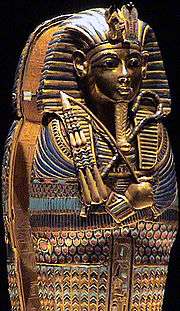Crook and flail
The crook (heka) and flail (nekhakha) are symbols used in Ancient Egyptian society. They were originally the attributes of the deity Osiris that became insignia of pharaonic authority.[1] The shepherd's crook stood for kingship and the flail for the fertility of the land.[1]

| crook in hieroglyphs |
|---|
| flail in hieroglyphs |
|---|
The earliest known example of a royal crook is from the Gerzeh culture (Naqada II), and comes from tomb U547 in Abydos. By late Predynastic times, the shepherd's crook was already an established symbol of rule. The flail initially remained separate, being depicted alone on some earliest representations of royal ceremonial. Approximately by the time of the Second Dynasty the crook and flail became paired.
The only extant pharaonic examples of both the crook and flail come from the tomb of Tutankhamun.[2] Their staffs are made of heavy bronze covered with alternating stripes of blue glass, obsidian, and gold, while the flail's beads are made of gilded wood.[3]
Theories on significance
Traditionally crossed over the chest when held, they probably represented the ruler as a shepherd whose beneficence is formidably tempered with might.[2]
In the interpretation of Toby Wilkinson, the flail, used to goad livestock, was a symbol of the ruler's coercive power: as shepherd of his flock, the ruler encouraged his subjects as well as restraining them.[4]
Still another interpretation, by E. A. Wallis Budge, is that the flail is what was used to thresh grain.[5]
References
- Steele, Philip (2002). Ancient Egypt. The Rosen Publishing Group. p. 12. ISBN 1435851730.
- "Tutankhamun "Wonderful Things" From The Pharaoh's Tomb" (PDF). Herkimer Community Museum. p. 75. Archived from the original (PDF) on 3 September 2013. Retrieved 10 May 2014.
- Allen, Susan (2006). Tutankhamun's Tomb: The Thrill of Discovery. Metropolitan Museum of Art. p. 100. ISBN 1588391892.
- Wilkinson, Toby A.H. (1999). Early Dynastic Egypt. Routledge. p. 190. ISBN 0-415-18633-1.
- Budge, Wallis (1971). Egyptian Magic. Dover. p. 72. ISBN 0486226816.
| Wikimedia Commons has media related to Crook and flail. |